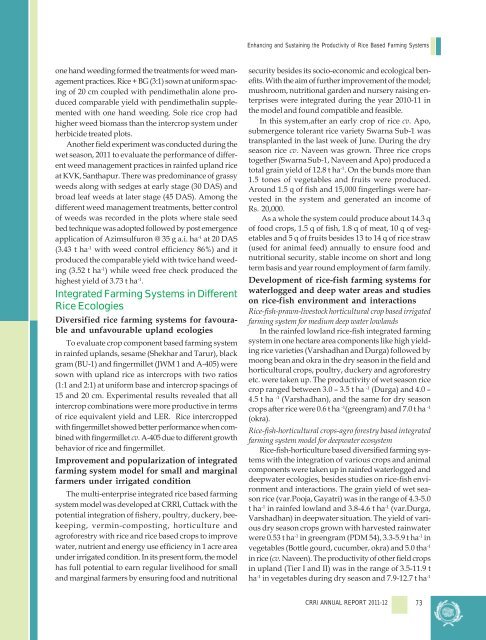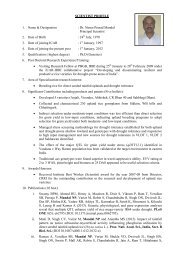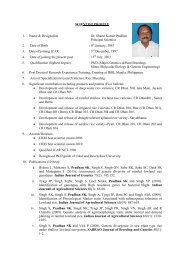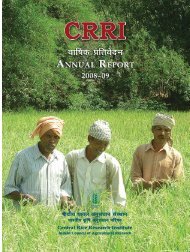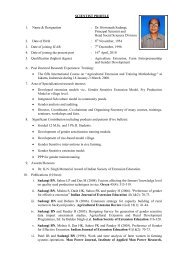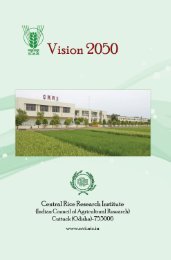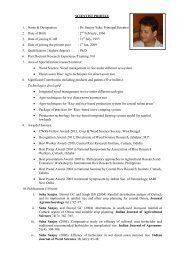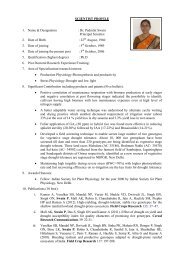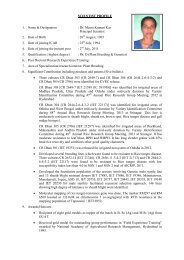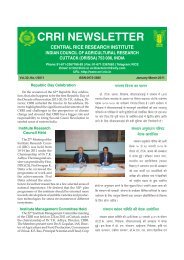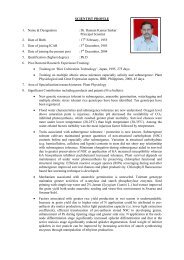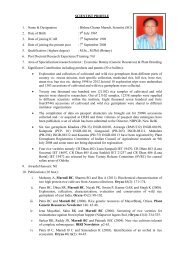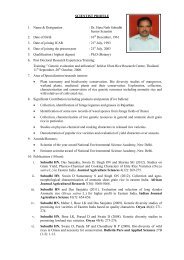Central Rice Research Institute Annual report...2011-12
Central Rice Research Institute Annual report...2011-12
Central Rice Research Institute Annual report...2011-12
You also want an ePaper? Increase the reach of your titles
YUMPU automatically turns print PDFs into web optimized ePapers that Google loves.
Enhancing and Sustaining the Productivity of <strong>Rice</strong> Based Farming Systems<br />
one hand weeding formed the treatments for weed management<br />
practices. <strong>Rice</strong> + BG (3:1) sown at uniform spacing<br />
of 20 cm coupled with pendimethalin alone produced<br />
comparable yield with pendimethalin supplemented<br />
with one hand weeding. Sole rice crop had<br />
higher weed biomass than the intercrop system under<br />
herbicide treated plots.<br />
Another field experiment was conducted during the<br />
wet season, 2011 to evaluate the performance of different<br />
weed management practices in rainfed upland rice<br />
at KVK, Santhapur. There was predominance of grassy<br />
weeds along with sedges at early stage (30 DAS) and<br />
broad leaf weeds at later stage (45 DAS). Among the<br />
different weed management treatments, better control<br />
of weeds was recorded in the plots where stale seed<br />
bed technique was adopted followed by post emergence<br />
application of Azimsulfuron @ 35 g a.i. ha -1 at 20 DAS<br />
(3.43 t ha -1 with weed control efficiency 86%) and it<br />
produced the comparable yield with twice hand weeding<br />
(3.52 t ha -1 ) while weed free check produced the<br />
highest yield of 3.73 t ha -1 .<br />
Integrated Farming Systems in Different<br />
<strong>Rice</strong> Ecologies<br />
Diversified rice farming systems for favourable<br />
and unfavourable upland ecologies<br />
To evaluate crop component based farming system<br />
in rainfed uplands, sesame (Shekhar and Tarur), black<br />
gram (BU-1) and fingermillet (JWM 1 and A-405) were<br />
sown with upland rice as intercrops with two ratios<br />
(1:1 and 2:1) at uniform base and intercrop spacings of<br />
15 and 20 cm. Experimental results revealed that all<br />
intercrop combinations were more productive in terms<br />
of rice equivalent yield and LER. <strong>Rice</strong> intercropped<br />
with fingermillet showed better performance when combined<br />
with fingermillet cv. A-405 due to different growth<br />
behavior of rice and fingermillet.<br />
Improvement and popularization of integrated<br />
farming system model for small and marginal<br />
farmers under irrigated condition<br />
The multi-enterprise integrated rice based farming<br />
system model was developed at CRRI, Cuttack with the<br />
potential integration of fishery, poultry, duckery, beekeeping,<br />
vermin-composting, horticulture and<br />
agroforestry with rice and rice based crops to improve<br />
water, nutrient and energy use efficiency in 1 acre area<br />
under irrigated condition. In its present form, the model<br />
has full potential to earn regular livelihood for small<br />
and marginal farmers by ensuring food and nutritional<br />
security besides its socio-economic and ecological benefits.<br />
With the aim of further improvement of the model;<br />
mushroom, nutritional garden and nursery raising enterprises<br />
were integrated during the year 2010-11 in<br />
the model and found compatible and feasible.<br />
In this system,after an early crop of rice cv. Apo,<br />
submergence tolerant rice variety Swarna Sub-1 was<br />
transplanted in the last week of June. During the dry<br />
season rice cv. Naveen was grown. Three rice crops<br />
together (Swarna Sub-1, Naveen and Apo) produced a<br />
total grain yield of <strong>12</strong>.8 t ha -1 . On the bunds more than<br />
1.5 tones of vegetables and fruits were produced.<br />
Around 1.5 q of fish and 15,000 fingerlings were harvested<br />
in the system and generated an income of<br />
Rs. 20,000.<br />
As a whole the system could produce about 14.3 q<br />
of food crops, 1.5 q of fish, 1.8 q of meat, 10 q of vegetables<br />
and 5 q of fruits besides 13 to 14 q of rice straw<br />
(used for animal feed) annually to ensure food and<br />
nutritional security, stable income on short and long<br />
term basis and year round employment of farm family.<br />
Development of rice-fish farming systems for<br />
waterlogged and deep water areas and studies<br />
on rice-fish environment and interactions<br />
<strong>Rice</strong>-fish-prawn-livestock horticultural crop based irrigated<br />
farming system for medium deep water lowlands<br />
In the rainfed lowland rice-fish integrated farming<br />
system in one hectare area components like high yielding<br />
rice varieties (Varshadhan and Durga) followed by<br />
moong bean and okra in the dry season in the field and<br />
horticultural crops, poultry, duckery and agroforestry<br />
etc. were taken up. The productivity of wet season rice<br />
crop ranged between 3.0 – 3.5 t ha -1 (Durga) and 4.0 –<br />
4.5 t ha -1 (Varshadhan), and the same for dry season<br />
crops after rice were 0.6 t ha -1 (greengram) and 7.0 t ha -1<br />
(okra).<br />
<strong>Rice</strong>-fish-horticultural crops-agro forestry based integrated<br />
farming system model for deepwater ecosystem<br />
<strong>Rice</strong>-fish-horticulture based diversified farming systems<br />
with the integration of various crops and animal<br />
components were taken up in rainfed waterlogged and<br />
deepwater ecologies, besides studies on rice-fish environment<br />
and interactions. The grain yield of wet season<br />
rice (var.Pooja, Gayatri) was in the range of 4.3-5.0<br />
t ha -1 in rainfed lowland and 3.8-4.6 t ha -1 (var.Durga,<br />
Varshadhan) in deepwater situation. The yield of various<br />
dry season crops grown with harvested rainwater<br />
were 0.53 t ha -1 in greengram (PDM 54), 3.3-5.9 t ha -1 in<br />
vegetables (Bottle gourd, cucumber, okra) and 5.0 tha -1<br />
in rice (cv. Naveen). The productivity of other field crops<br />
in upland (Tier I and II) was in the range of 3.5-11.9 t<br />
ha -1 in vegetables during dry season and 7.9-<strong>12</strong>.7 t ha -1<br />
CRRI ANNUAL REPORT 2011-<strong>12</strong><br />
73


